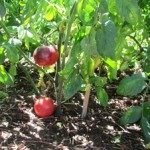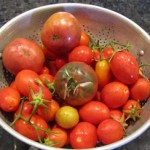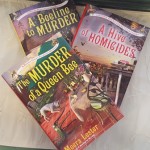Saving Tomato Seeds
In my Henny Penny Farmette garden this year, I grew different varieties of heirloom tomatoes: German Queen, Mortgage Lifter, Paul Robson (a Russian heirloom), Mt. Vesuvius, San Marzano, and others.
It’s the end of the season and my work now is to save seed and compost other plants that are no longer producing. Over the next couple of months, I’ll turn the soil and add amendments.
Since my tomato plants are open-pollinated, heirloom types (as opposed to patented hybrids), I can have a reasonable expectation of how the seeds will perform once planted in a future garden.
A word of warning about using patented hybrid seeds–growing plants from hybrid seed will not come true in your next year’s garden. They will likely be inferior plants compared to their parents.
However, open-pollinated seeds produce tomato plants that remain true to the parent plants (of course, some slight variation in nature is possible). But you can know with certainty that those seeds will remain true just as they have through generations of gardens.

These are heirloom blue tomatoes. Avoid planting tomatoes in the same garden location year after year because of tomato blight and black rot. Let the soil recover for three years–tomatoes are heavy feeders.
When choosing which tomatoes to save seed from, keep two criteria in mind:
1) Choose tomatoes from vigorous plants, free of disease.
2) Select seed from tomatoes with characteristics (like the taste, skin thickness, size, and abundance) that you prefer.
I utilize a simple three-step method for saving my tomato seeds. I always select a prime tomato specimen that has reached its peak to be used for harvesting seed.
1. Use a sheet of paper towel for each type of tomato seed you are saving. Write on one corner of the paper towel the type of tomato seed and the year grown and whether determinate (often called bush) or indeterminate (vine which will keep growing until killed by frost). Most heirloom tomatoes are indeterminate.
2. Cut open the tomato and then scrape out seeds and spread them out across a paper towel. I put these towels on my kitchen counter or in a window to dry for 10-14 days.
3. Fold the paper towel and slip it into a paper envelope to use for your next year’s garden. I use one envelope per paper towel to ensure air circulation for good drying.
Come spring, these seeds can be planted into cell packs to become seedlings. Or, you can plant them directly into the garden after all danger of frost has passed.
___________________________________________________________________
If you enjoy reading about garden topics and like mysteries, check out my Henny Penny Farmette series of cozy mysteries, including A BEELINE TO MURDER, THE MURDER OF A QUEEN BEE, and A HIVE OF HOMICIDES (Kensington Publishing, NY).
I’ve also written dozens of health and wellness and spirituality books, all available online and everywhere books are sold.

More than 150 rituals for sound mind, strong body, and meaningful connections to the people around you
 Facebook
Facebook Goodreads
Goodreads LinkedIn
LinkedIn Meera Lester
Meera Lester Twitter
Twitter








